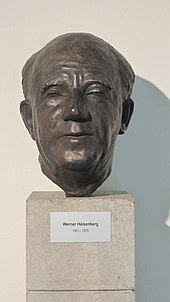Garching
Garching bei München | |
|---|---|
 Garching | |
Location of Garching bei München within Munich district  | |
Upper Bavaria | |
| District | Munich |
| Government | |
| • Mayor (2020–26) | Dietmar Gruchmann (SPD) |
| Area | |
| • Total | 28.16 km2 (10.87 sq mi) |
| Elevation | 481 m (1,578 ft) |
| Population (2022-12-31)[1] | |
| • Total | 17,526 |
| • Density | 620/km2 (1,600/sq mi) |
| Time zone | UTC+01:00 (CET) |
| • Summer (DST) | UTC+02:00 (CEST) |
| Postal codes | 85748 |
| Dialling codes | 089 |
| Vehicle registration | M |
| Website | www |
Garching bei München (German: [ˈɡaʁçɪŋ baɪ̯ ˈmʏnçn̩], Garching near Munich) or Garching is a city in Bavaria, near Munich. It is the home of several research institutes and university departments, located at Campus Garching.
History
Spatial urban planning

Garching was small Bavarian village, until the
In 1963
After World War II the scientific publishing business started off slowly and had to be relaunched.
Districts
The town has four districts:
- Garching city
- Garching Hochbrück
- Campus Garching (University and Research Campus)
High-tech hub
Garching is part of the Nordallianz, a group of 8 towns and cities situated north of Munich.
Transport
The town is at 48°15′N 11°39′E / 48.250°N 11.650°E, near the river
The
University and research institutes
Several research and scientific educational institutions are based in Garching, including:
- Bavarian Academy of Sciences and Humanities
- Technical University of Munich (TUM)
- TUM Department of Physics
- FRM-II research reactor
- Walter Schottky Institute semiconductor physics and engineering
- TUM Department of Chemistry
- TUM Department of Mechanical Engineering
- TUM Department of Mathematics
- TUM Department of Informatics
- Institutes of the Max Planck Society (MPG)
- Max Planck Institute for Astrophysics (MPA)
- Max Planck Institute for Extraterrestrial Physics (MPE)
- Max Planck Institute for Plasma Physics (IPP)
- Max Planck Institute for Quantum Optics(MPQ)
- Max Planck Computing and Data Facility (MPCDF)
- European Southern Observatory (ESO)
- Federal Research Institute for Food Chemistry (Deutsche Forschungsanstalt für Lebensmittelchemie DFA)
- Bavarian Center of Applied Energy Research (ZAE)
- General Electric Global Research Center
- BMW M high-performance vehicle research and development
Twin towns
Garching bei München is
Sport
The town's football club VfR Garching, formed in 1921, experienced its greatest success in 2014 when it won promotion to the Regionalliga Bayern for the first time.
References
- ^ Genesis Online-Datenbank des Bayerischen Landesamtes für Statistik Tabelle 12411-003r Fortschreibung des Bevölkerungsstandes: Gemeinden, Stichtag (Einwohnerzahlen auf Grundlage des Zensus 2011).
- ISBN 9780262083690.
- ISBN 9780262083690.
- ISBN 9780262083690.
- ISBN 9780262083690.
- ISBN 9780521821704.
- ISBN 9780521821704.

